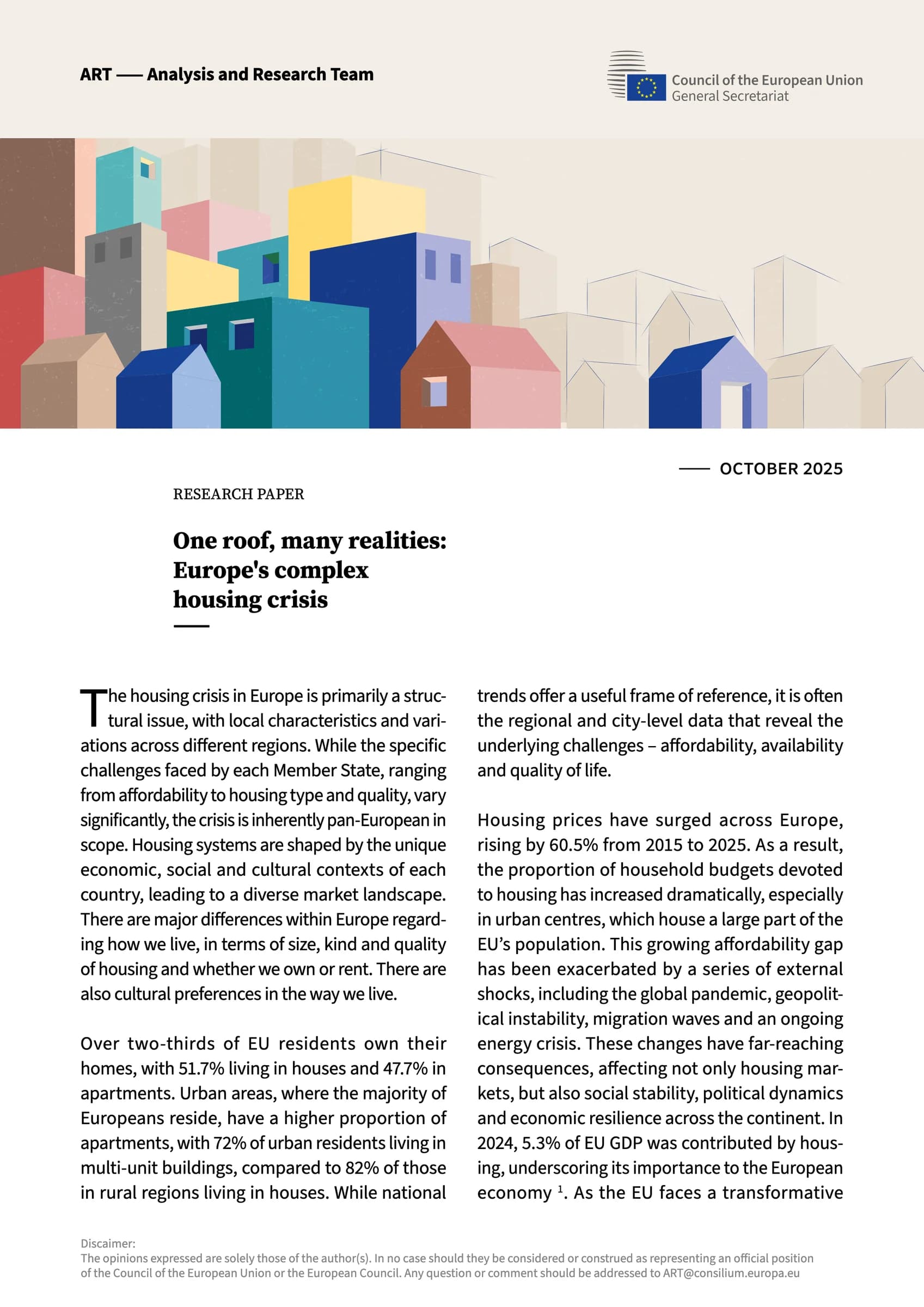One roof, many realities: Europe's complex housing crisis
🏠Context and Publication Overview
This research paper, published by the Analysis and Research Team (ART) of the Council of the European Union, addresses the multifaceted housing crisis affecting Europe. The crisis is characterized as largely structural, with varying local challenges and conditions across member states. The report emphasizes that while each country faces unique issues, the housing crisis is fundamentally pan-European in scope, driven by economic, social, and cultural factors.
📊Key Data on Housing Trends
Over two-thirds of EU residents own their homes, with 51.7% living in houses and 47.7% in apartments. Urban areas show a greater prevalence of apartments, as 72% of urban residents reside in multi-unit buildings. The rising housing prices from 2015 to 2025 have increased by 60.5%, significantly impacting household budgets, especially in urban centers. The percentage of household budgets allocated to housing has surged, exacerbated by external shocks including the global pandemic and the ongoing energy crisis.
💡Affordability and Economic Impact
In 2024, 5.3% of the EU's GDP was attributed to housing, highlighting its economic significance. The affordability gap has widened, with one in ten EU households unable to pay rent or mortgage on time. Rising housing costs have led to increased financial difficulties for many, particularly in urban areas where living expenses are higher. The report notes that housing prices have surged dramatically, especially in Eastern and Baltic states, where prices have more than tripled in some cases.
🏗️Construction Challenges
The report highlights a significant lag in new housing construction, with estimates suggesting that nearly 1 million new dwellings are needed to meet current demand. Construction costs surged by 56% from 2010 to 2024, limiting the supply of affordable housing. Delays in residential construction have been attributed to various factors, including the global pandemic, rising interest rates, and administrative hurdles. Notably, the lack of innovation within the construction sector further complicates meeting housing needs.
🌍Urbanization and Demographics
With urbanization projected to reach 83% by 2050, European cities are grappling with increasing housing demand alongside structural challenges. Urban areas are experiencing rising property prices, which are becoming unaffordable for many residents. The demographic shifts and an ageing population further complicate the housing landscape, as smaller households become more common, driving the need for diverse housing options.
🏘️Evolving Housing Needs
The existing housing stock is increasingly inadequate, with a notable shortage of affordable units for low-income households and young people. The report indicates a mismatch between the current housing supply and the evolving demands of society. Additionally, rising energy costs and inadequate energy efficiency in older buildings contribute to the growing affordability crisis, with many homes built before 2000 lacking proper energy performance ratings.
💼Financialization of Housing
The report discusses the financialization of housing, where institutional investors increasingly treat housing as a financial asset. This trend has implications for affordability, as institutional investors tend to focus on higher-end developments rather than creating affordable housing options. The impact of short-term rentals, often dominated by professional hosts, has further strained the long-term rental market in key urban areas.
🔍Conclusion and Future Implications
The housing crisis presents significant challenges across the EU, affecting economic stability, social cohesion, and political dynamics. While individual member states have different perspectives on how to address the crisis, the need for a collaborative, pan-European approach is vital. The report underscores the importance of recognizing housing not only as a social issue but also as a critical factor in economic competitiveness and societal well-being.

